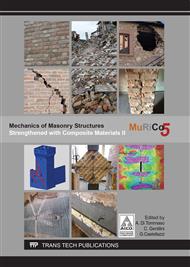p.628
p.638
p.646
p.653
p.662
p.670
p.678
p.686
p.694
Collapse State of Multi-Storey Masonry Walls Reinforced by Steel Ties Subjected to In-Plane Horizontal Loads
Abstract:
The determination of the seismic strength of masonry building is strictly connected to the in-plane strength of masonry walls under the action of horizontal forces. Simplified criteria are currently available in literature, based on modelling of the structure as loaded by dead loads and by a gradually increasing distribution of horizontal forces, proportional to the mass of the building. According to this approach, called push-over method, the seismic strength of the building corresponds to the intensity of these gradually increasing horizontal loads, leading the building to the failure condition. This paper moves in the framework of the Limit Analysis, based on the Heyman’s masonry model (1966), rigid in compression with no tensile strength. The resistant model refers to a multi-storey wall with openings arranged in regular patterns, along both vertical and horizontal directions, reinforced at floor levels by steel ties. The in-plane failure of the regular multi-storey walls can occur with the development of various kinematically admissible mechanisms, characterized by the attainment of the yielding state in the steel ties. The proposed methodology consists in the definition of the mechanism along which the failure effectively occurs and in a subsequent check of the statical admissibility of the internal stress state at the limit load. Only in this case, the corresponding kinematical multiplier is the effective collapse multiplier. The presence of the panels situated above the openings strongly conditions the in-plane failure of the wall, acting as diagonal struts, causing different horizontal displacements between the piers at the floor levels and consequently engaging the horizontal ties in the mechanism. In order to ensure the development of the global failure, avoiding local brittle failures, steel strengths of the ties have thus to be suitably defined. Finally, a parametric investigation is carried out considering different geometries of masonry walls and varying the position of the piers self-weights and the horizontal forces distribution, constant or proportional to the height of the masses from the foundation level.
Info:
Periodical:
Pages:
686-693
Citation:
Online since:
July 2017
Authors:
Price:
Сopyright:
© 2017 Trans Tech Publications Ltd. All Rights Reserved
Share:
Citation:


